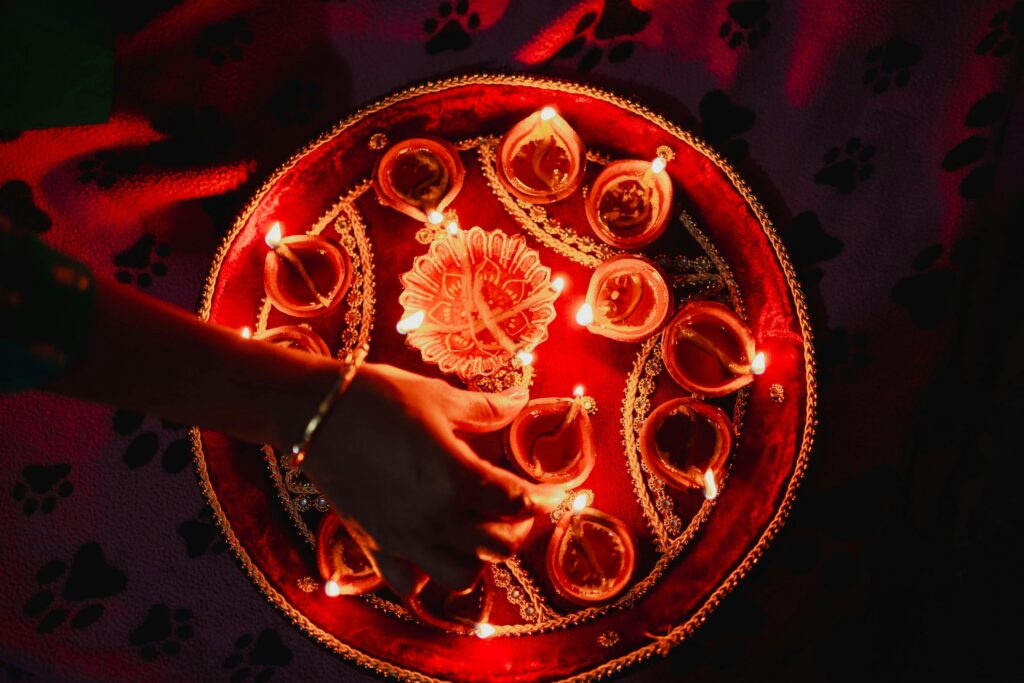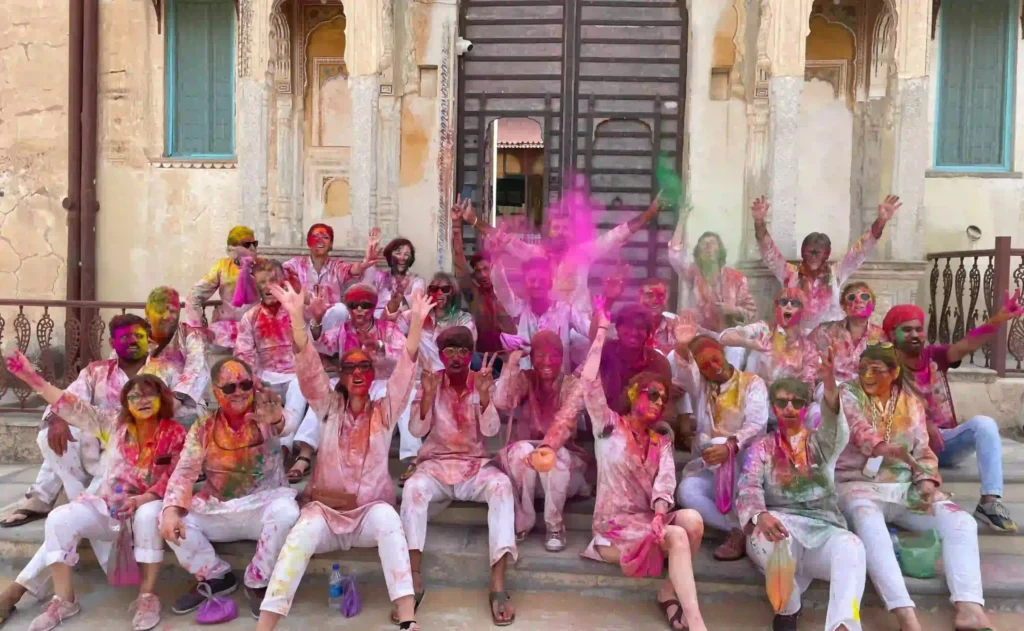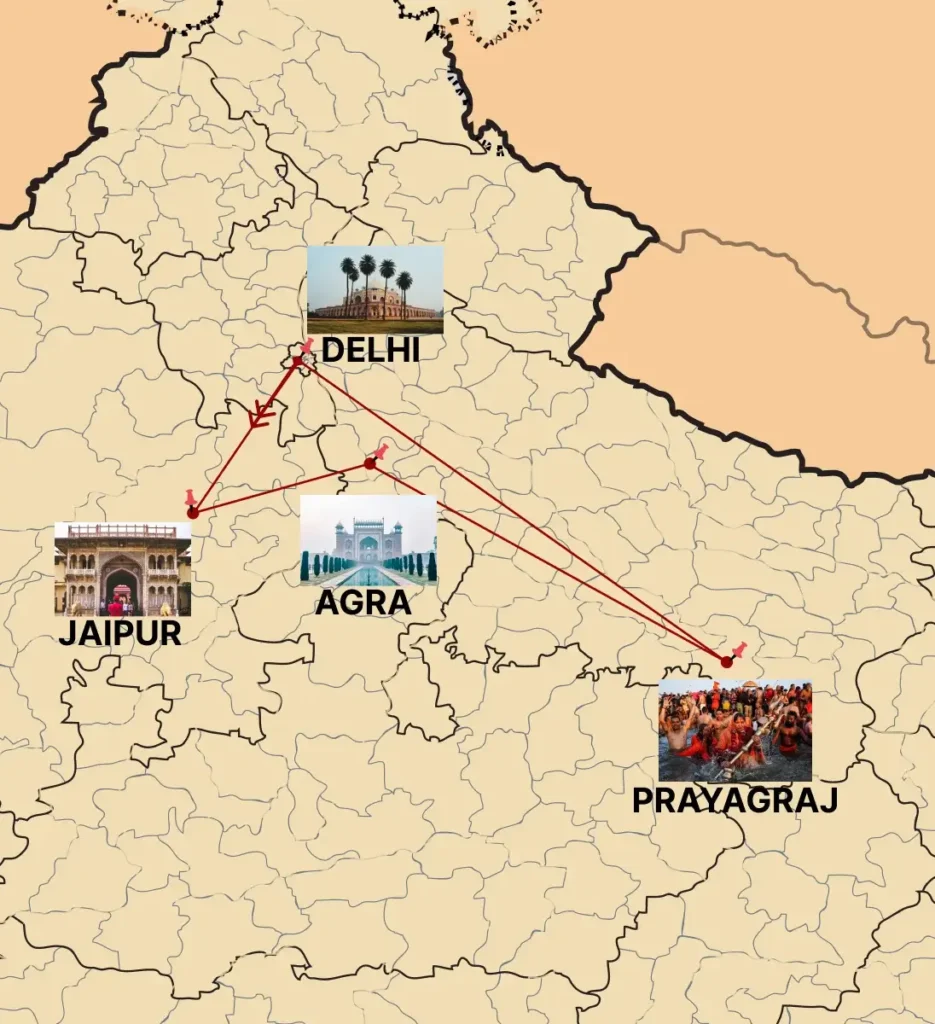About | Inclusions | Excluded Services | Pricing | What makes this trip Special? | Itinerary | Map | FAQ
Designed For
Spiritual, Cultural & Artistic Interests
Corporate Travel
Friends & Family Travel
Solo Travel
Holi - A Joyful Start to Spring
It’s hard to explain what Kumbh Mela really feels like — it’s not just an event. It’s a pull—a calling.
Every twelve years, millions make their way to the riverbanks of the Ganges, Yamuna, or other holy spots. Not for the crowd. Not for photos. They come for the water. One dip — that’s what they believe washes away lifetimes of sins.
You’ll see sadhus covered in ash, pilgrims walking barefoot for days, and rituals that feel ancient and alive all at once. Some take things to the extreme — walking on nails, carrying heavy loads, or whipping themselves — all to show their devotion.
It’s loud, chaotic, emotional, beautiful — sometimes all at once. You’ll smell incense and earth, hear conch shells, and feel the vibration of chants in your chest.
We won’t rush you through it. We’ll walk beside you, letting you take it in your own way. It’s not something you “see” — it’s something you feel.
Inclusions
15 nights, chosen hotels
Local driver, guide
Daily breakfast
All costs covered
In Car Wi-fi
Cooking classes, dinner
Airport transfer
Delhi rickshaw
- Flights: International or Domestic
- Drinks: Unless specified.
- Visa: Obtain your Indian visa independently.
- Meals: Not specified.
- Tips: Housekeeping, bellboys, at your discretion.
- Insurance: Comprehensive travel insurance required.
- Expenses: Laundry, telephone bills.
- Entrance: Monument fees.
- Camera: Video camera fees.
- Health: Medical, baggage insurance.
- Taxes: Airport departure taxes.
- Others: Unspecified services.
- Safaris: Game safaris not included, unless specified.
What makes this trip Special?
The Royal Bath
Join the crowds at Shahi Snan — the Kumbh’s most sacred and powerful ritual.
Meet the Sadhus
Visit Akhara camps and witness the life and rituals of India’s holy men.
Sunset Boat Ride
Drift along the Ganges at sunset — a quiet break from the crowd.
Listen to Spiritual Talks
Attend open-air discourses where saints and gurus share ancient wisdom.
Timeless Beauty of the Taj
Visit the Taj Mahal — a white marble wonder and symbol of eternal love, glowing at sunrise.
Experience the Pulse of India
Delhi is busy, bold, and full of stories — every corner has something to offer.
Detailed Itinerary
You land in Delhi — we’ll be there with your name on a sign, ready to get you to your hotel. You can rest or head out right away — no pressure either way.
When you’re ready, we’ll explore. Delhi’s a layered city — some parts calm and green, others buzzing and full of life. You’ll see India Gate, Parliament, and the President’s residence — the official face of the city.
Then there’s Gandhi’s memorial, and Qutub Minar — tall, striking, and older than most countries.
Old Delhi is the opposite of quiet. It’s all noise, colour, spices, and street food. A rickshaw ride through here is unforgettable — passing Jama Masjid, the Red Fort, and Raj Ghat where Gandhi was cremated.
For something softer, we’ll visit Bangla Sahib Gurudwara — peaceful, with volunteers cooking for hundreds every day. Nizamuddin Dargah is also special — if you’re lucky, there’s live qawwali at sunset.
We’ll also take time for Humayun’s Tomb, the surreal Lotus Temple, and the intricate carvings of Akshardham. If you like markets, Chandni Chowk will keep you busy (and possibly lost — in the best way).
Your time here is yours. We’ll plan around you. No tight schedules, no rush.
Next stop: Jaipur — the Pink City. Around five hours’ drive from here.
Welcome to Jaipur — the Pink City. It’s got that old-world charm but doesn’t feel stuck in the past. You’ll see palaces and forts, but also scooters zipping past in narrow lanes and colourful markets spilling onto the street.
We’ll check out the City Palace first — still home to royalty — and then head to Hawa Mahal, that honeycomb-looking building that’s all over postcards. It’s even better in real life.
Amber Fort is a bit outside the city, but totally worth the drive — huge courtyards, mirror-covered walls, and hilltop views. On the way back, we might stop at Jal Mahal — a palace floating in the middle of a lake. Peaceful spot.
Wander the old city if you’re up for it — pink buildings, buzzing shops. And if shopping’s your thing, Johri Bazaar and Choti Chaupar have jewellery, textiles, and stuff you won’t find in a mall.
We go at your pace. No rush, no fixed script.
Next up: Agra — about 4.5 hours on the road.
Agra is all about the Taj — and honestly, it’s just as dreamy as people say. We’ll try to catch the sunset from across the river first — soft light, fewer crowds, and that golden glow on the marble.
Sunrise? Even better. If you’re up for an early start, we’ll get there before the gates open. The quiet, the cool air, the first rays hitting the dome — it’s unforgettable.
If there’s time, the Agra Fort is just a few minutes away and full of stories. And if you want more, there’s Fatehpur Sikri, Akbar’s tomb, the “Baby Taj” (Itimad-ud-Daula), and a giant mosque right nearby.
Oh, and quick heads-up: the Taj is closed on Fridays, so we’ll plan around that.
After soaking in the Mughal magic, we’re off to Haridwar — about 6.5 hours from here.
This stretch of the trip slows everything down — in a good way.
Prayagraj is where three holy rivers meet: Ganga, Yamuna, and the mythical Saraswati. It’s a powerful place. People have been coming here for centuries to pray, to wash away sins, to just be.
You’ll see rituals at sunrise, lines of people heading into the water, quiet chants floating in the air. It’s not a performance — it’s deep, real devotion.
If we time it right, you might see a big gathering at the riverbank — saffron robes, glowing lamps, and the kind of silence that isn’t really silent.
No set route here. Just space to take it all in.
Next up: Delhi — about a 5-hour drive.
You’ve got two ways to go today — totally your call.
If you just want to relax, hang out at the hotel, maybe catch up on rest or go through your photos — go for it. You’ve earned it.
But if you’re up for one last wander, we can hit the markets — Chandni Chowk’s a maze of colours, snacks, spices, and surprises. Or, if you’re leaning toward something quieter, we can stop by the Fatehpuri Mosque or the nearby Jain Temple — both tucked into the old city’s corners.
No pressure either way. We’ll plan the day around how you’re feeling.
Time to head home.
Your driver will be ready and make sure you get to the airport on time — no last-minute stress. Hopefully, you’re leaving with full memory cards, a few stories, and something in your heart you didn’t have when you came.
Safe journey. And who knows — maybe you’ll be back someday.
Plan Freely with All-Inclusive Pricing
Keep Exploring
Go beyond Kumbh with more cultural and offbeat tours.

Diwali Festival Tour
Days : 20
Step into the warmth of India’s Festival of Lights — come celebrate Diwali the local way.

Holi Festival Tour
Days : 16
Celebrate Holi with locals through colours, music, and tradition.

Pushkar Camel Carnival
Days : 16
Experience India’s most vibrant desert fair — with camels, color, and culture.
Frequently Asked Questions
India offers a diverse range of unique activities, experiences, and attractions, making it an ideal destination for family travel. The country’s warm hospitality and rich cultural traditions create an enriching environment for young travelers, and children are warmly welcomed everywhere they go. Whether you’re seeking natural beauty, historical sites, bustling cities, or vibrant festivals like Holi or the Pushkar Fair, India has it all. Sanitation, and hygiene (WASH) programming to protect everyone’s long-term health.
When it comes to personal safety and the well-being of your travel group, India is generally considered a safe destination. English is widely spoken and easily accessible, making navigation straightforward. However, it’s advisable to take common-sense safety precautions, as you would when traveling anywhere in the world. Having a local tour guide can be invaluable for identifying safe areas to explore and recommending hygienic dining options. It’s essential for international tourists to avoid drinking tap water and opt for bottled water during their stay.
India offers a wide range of accommodations to suit various budgets and preferences. From opulent palace hotels to Western-style chain hotels and budget-friendly hostels, you’ll find numerous options. Note that overnight stays are typically not permitted in wildlife sanctuaries and national parks, but you can easily find private accommodations on the outskirts of these areas. Hotel rates vary depending on the season and location. At IHT, we select accommodations that are not only comfortable but also maintain high hygiene standards. We provide boutique experiences for international guests and luxury hotels to ensure your stay is memorable.
To confirm a booking with us, we require an advance payment, typically a percentage of the total cost, to secure your reservation. The remaining balance can be paid according to the agreed-upon payment plan for your journey. In some cases, such as during peak or holiday seasons, full payment may be required to confirm your reservation. We accept payments via Visa, MasterCard, and American Express, with a small bank processing fee for credit card payments. Alternatively, you can make a direct payment through a wire transfer to our bank account, with no additional fees. We will provide you with our billing and bank details at the time of invoicing, which you will receive after confirming your bookings.
Most international travelers need to obtain a visa before visiting India. It’s essential to contact your local Indian embassy for guidance on the visa application process. Tourist visas are typically valid for six months, and it’s necessary to have at least two blank pages in your passport when applying. India also offers e-visa options for convenience.
Before traveling to India, ensure your travel insurance covers loss of personal items, personal accidents, medical emergencies, emergency travel expenses, and trip cancellation. We require all guests traveling with Incredible Real India to have travel insurance.
We recommend discussing vaccination requirements with your healthcare provider, as we cannot provide medical advice.
In the event of a medical emergency or any unfavorable incident, our team is readily available to assist you. Your safety is our top priority, and we maintain constant communication with our vehicles on the road. Additionally, we provide contact information for private doctors and medical facilities in your journey documents, and most hotels partner with doctors for 24-hour on-call services.
Our restaurant and hotel selections can cater to specific dietary requirements.
Tipping practices vary by location. On some journeys, certain gratuities are included. Typically, it’s customary to tip the car or bus driver, driver’s assistant (if applicable), local tour guide, as well as waitstaff, hotel housekeeping, and hotel porters.
India’s climate varies from region to region. Winters are generally cool and fresh from November to March, while hot and dry temperatures, along with dust storms and coastal humidity, prevail from April to June. The best time to visit the Himalayas is during the monsoon season when the rest of the country experiences heavy rainfall.
Major international airports in India have currency exchange counters. Most hotels can also assist with currency exchange. It’s a good practice to carry sufficient local currency for basic expenses, as some wildlife resorts may not offer currency exchange facilities. There are no specific restrictions on the amount of foreign currency or traveler’s checks you can bring into India, but you’ll need to fill out a declaration form upon arrival.
While major cities accept MasterCard and Visa, Diner’s Club and American Express cards may not be as widely accepted. ATMs are readily available in major cities, but carrying some Indian currency is advisable for smaller locations and for tipping.
India has extensive telecom coverage, with mobile phones working in most areas. However, not all mobile operators have the same coverage quality. Some remote areas, such as national parks and mountainous regions, may have limited network access. Most hotels offer internet facilities, and you can find internet cafes in cities. Acquiring a local prepaid mobile number can be cost- effective, and our cars and buses provide free Wi-Fi access for your convenience.

